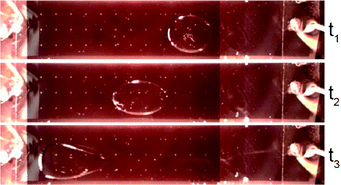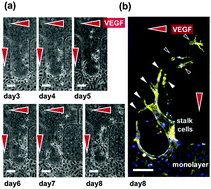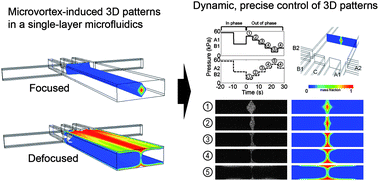 This Communication from Nathan B. Crane (University of South Florida) et al. describes new method of droplet transport, combining diode-like conduction and electrowetting on dielectric to achieve continuous electrowetting with a single electrode.
This Communication from Nathan B. Crane (University of South Florida) et al. describes new method of droplet transport, combining diode-like conduction and electrowetting on dielectric to achieve continuous electrowetting with a single electrode.
Continuous electrowetting via electrochemical diodes
Christopher W. Nelson, Corey M. Lynch and Nathan B. Crane
Lab Chip, 2011, 11, 2149-2152
DOI: 10.1039/C1LC20196D
 In their paper Seok Chung (Korea University) et al. have developed a hydrogel incorporating a microfluidic platform which can mimic the 3D tissue microenvironment for the study of endothelial cell sprouting angiogenesis. They are able to precisely control the gradient of soluble angiogenic factors, VEGF and ANG-1 and obtain a quantitative response to the assay.
In their paper Seok Chung (Korea University) et al. have developed a hydrogel incorporating a microfluidic platform which can mimic the 3D tissue microenvironment for the study of endothelial cell sprouting angiogenesis. They are able to precisely control the gradient of soluble angiogenic factors, VEGF and ANG-1 and obtain a quantitative response to the assay.
In vitro 3D collective sprouting angiogenesis under orchestrated ANG-1 and VEGF gradients
Yoojin Shin, Jessie S. Jeon, Sewoon Han, Gi-Seok Jung, Sehyun Shin, Sang-Hoon Lee, Ryo Sudo, Roger D. Kamm and Seok Chung
Lab Chip, 2011, 11, 2175-2181
DOI: 10.1039/C1LC20039A
 William C. Messner (Carnegie Mellon University) and colleagues have also been working in 3D to achieve dynamic control of 3D chemical patterns in a single 2D microfluidic platform. They are able to switch between ‘focused’ and ‘defocused’ 3D flow profiles, and to rapidly tune the patterns through feedback control of the inlet pressures.
William C. Messner (Carnegie Mellon University) and colleagues have also been working in 3D to achieve dynamic control of 3D chemical patterns in a single 2D microfluidic platform. They are able to switch between ‘focused’ and ‘defocused’ 3D flow profiles, and to rapidly tune the patterns through feedback control of the inlet pressures.
Dynamic control of 3D chemical profiles with a single 2D microfluidic platform
YongTae Kim, Sagar D. Joshi, Lance A. Davidson, Philip R. LeDuc and William C. Messner
Lab Chip, 2011, 11, 2182-2188
DOI: 10.1039/C1LC20077A
As with all our HOT papers, these are free to access for 4 weeks













